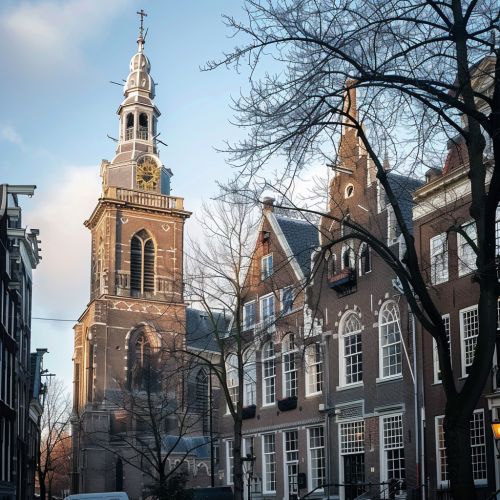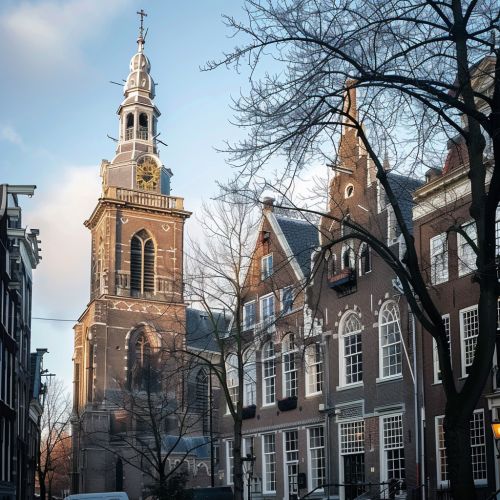Old Church (Amsterdam): Difference between revisions
(Created page with "== History == The Old Church (Oude Kerk) in Amsterdam is the city's oldest building and oldest parish church, consecrated in 1306 by the bishop of Utrecht with Saint Nicholas as its patron saint. The church stands in De Wallen, now Amsterdam's main red-light district. The square surrounding the church is the Oudekerksplein. Over time, the Old Church has undergone numerous modifications and expansions, reflecting the changing architectural styles and religious practices...") |
No edit summary |
||
| Line 23: | Line 23: | ||
The exterior of the Old Church is characterized by its Gothic elements, including pointed arches, flying buttresses, and large stained glass windows. The church's tower, added in the 16th century, is a notable feature, offering panoramic views of the city. | The exterior of the Old Church is characterized by its Gothic elements, including pointed arches, flying buttresses, and large stained glass windows. The church's tower, added in the 16th century, is a notable feature, offering panoramic views of the city. | ||
[[Image:Detail-97377.jpg|thumb|center|Exterior view of the Old Church in Amsterdam, showcasing its Gothic architecture and tower.|class=only_on_mobile]] | |||
[[Image:Detail-97378.jpg|thumb|center|Exterior view of the Old Church in Amsterdam, showcasing its Gothic architecture and tower.|class=only_on_desktop]] | |||
=== Interior === | === Interior === | ||
Latest revision as of 04:55, 28 July 2024
History
The Old Church (Oude Kerk) in Amsterdam is the city's oldest building and oldest parish church, consecrated in 1306 by the bishop of Utrecht with Saint Nicholas as its patron saint. The church stands in De Wallen, now Amsterdam's main red-light district. The square surrounding the church is the Oudekerksplein. Over time, the Old Church has undergone numerous modifications and expansions, reflecting the changing architectural styles and religious practices of the periods.
Early Construction
The initial construction of the Old Church began in the early 13th century. The original structure was a wooden chapel, which was later replaced by a stone church. The early Gothic style of the church is evident in its pointed arches and ribbed vaults. The church was expanded in the 14th and 15th centuries, with the addition of side chapels, a transept, and a choir.
Reformation and Iconoclasm
During the Protestant Reformation, the Old Church experienced significant changes. In 1578, the church was seized by the Calvinists during the Alteration, a peaceful revolution in Amsterdam that transferred power from the Catholic city government to a Protestant one. The church's interior was stripped of its Catholic ornaments and decorations during the Beeldenstorm, a wave of iconoclastic attacks that swept through the Low Countries.
Modern Era
In the 19th and 20th centuries, the Old Church underwent several restoration projects to preserve its historical and architectural significance. Today, the church is a prominent cultural and historical landmark in Amsterdam, hosting various events, exhibitions, and concerts.
Architecture
The Old Church is an exemplary model of Gothic architecture, with its intricate details and grandiose structure. The church's architecture reflects the various phases of its construction and the influences of different architectural styles over the centuries.
Exterior
The exterior of the Old Church is characterized by its Gothic elements, including pointed arches, flying buttresses, and large stained glass windows. The church's tower, added in the 16th century, is a notable feature, offering panoramic views of the city.


Interior
The interior of the Old Church is equally impressive, with its high vaulted ceilings, ornate wooden choir stalls, and intricate stained glass windows. The church's floor is composed of gravestones, as it served as a burial site for many prominent Amsterdam citizens.
Organ
The Old Church houses a magnificent organ, built in the 18th century by the famous organ builder Christian Müller. The organ is renowned for its rich sound and intricate design, making it a valuable historical and musical artifact.
Cultural Significance
The Old Church holds a significant place in Amsterdam's cultural and religious history. It has been a center of worship, community gatherings, and cultural events for centuries.
Religious Role
As the oldest parish church in Amsterdam, the Old Church has played a crucial role in the city's religious life. It has witnessed the transition from Catholicism to Protestantism and has adapted to the changing religious landscape of the city.
Community and Cultural Events
Today, the Old Church is a vibrant cultural center, hosting a variety of events, including art exhibitions, concerts, and lectures. The church's unique atmosphere and historical significance make it a popular venue for both locals and tourists.
Notable Burials
The Old Church is the final resting place of many notable individuals, including:
- Rembrandt's wife, Saskia van Uylenburgh.
- Admiral Karel Doorman, a Dutch naval hero.
- Jan Pieterszoon Sweelinck, a renowned Dutch composer and organist.
Preservation and Restoration
The preservation and restoration of the Old Church have been ongoing efforts to maintain its historical and architectural integrity. Various projects have been undertaken to repair and restore different parts of the church, ensuring its longevity for future generations.
Restoration Projects
Significant restoration projects have included the repair of the church's roof, the restoration of its stained glass windows, and the conservation of its wooden choir stalls and organ. These efforts have been supported by both public and private funding, highlighting the importance of the Old Church as a cultural and historical landmark.
See Also
- Gothic Architecture
- Protestant Reformation
- Iconoclasm
- Christian Müller (organ builder)
- Rembrandt van Rijn
